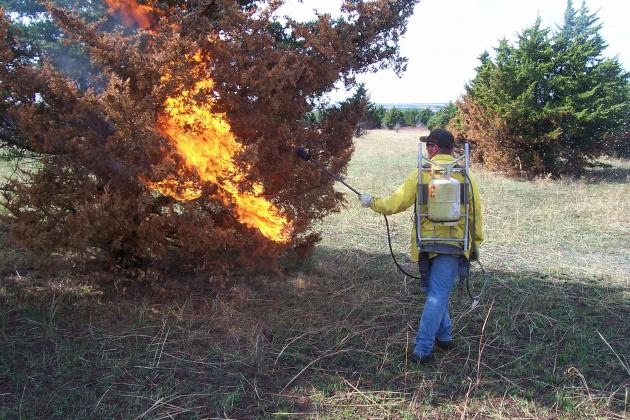
Prescribed burning is a vital part of successful land management in grassland and shrubland landscapes. Restoring fire often results in increased vegetation productivity and diversity of species (both plants and wildlife). There is great interest in using prescribed burning to restore pastures that are overrun by invasive plant species, particularly with the rising cost of herbicides. Several factors are important when considering whether prescribed fire will be useful in controlling invasive species.
Plant type
Successful control of invasive plant species often is determined by the type of plant that is targeted. Generally there are two broad categories used to characterize plants 1) resprouters and 2) non-resprouters. Resprouting plants are those that are capable of growing again from roots when the top is removed. Non-resprouting plants are incapable of growing again after the top is removed and die. Prescribed burning can be a very successful strategy when trying to control non-resprouting plants as it often will kill the plant. Resprouting plants can be much more difficult to control and fire is often used in tandem to other control methods such as grazing, herbicides and mechanical control.
Fire Return Interval
The fire return interval is how often a particular piece of land is burned. For example, if a pasture is burned every three years, then the fire return interval would be three years. Native plants evolved in regions with specific fire return intervals. For grasslands, research suggests that fire return intervals for tallgrass prairie were 3-5 years, 4-7 years for mix-grass prairie and 7-15 years for less productive short grass prairie. In western landscapes, return intervals can be much longer with sagebrush ecosystems burning every 50-100 years. Burning within these suggested return intervals will promote the plants native to that region. Burning more or less frequently may harm native plants and allow exotic and invasive plants to become more abundant.
Season of burn
Many regions have seasons when fire is more common than others. In landscapes where snow covers the vegetation during winter months, fire is limited to summer and fall months. Other regions where winters are mostly snow free, fire is common throughout the year. Plants that evolved with fire seem to be less affected by season of burn than those that evolved without fire. Burning plants when they are actively growing is a good strategy to suppress growth and reproduction of invasive plants. Over several burn cycles, this can greatly reduce the abundance of the target plant in pastures. Also, burning when plants are growing can be safer because fires are often slower and less intense.
Prescribed burning can be used to control invasive species, but a one-size fits all approach will not work and invasive species control must be included in a successful fire prescription.


